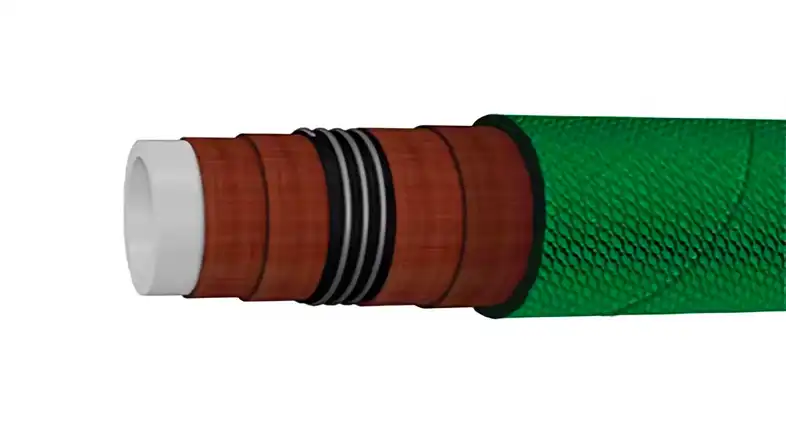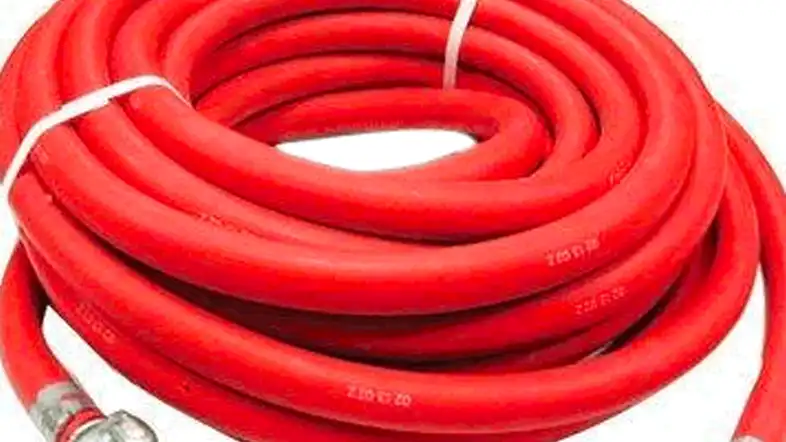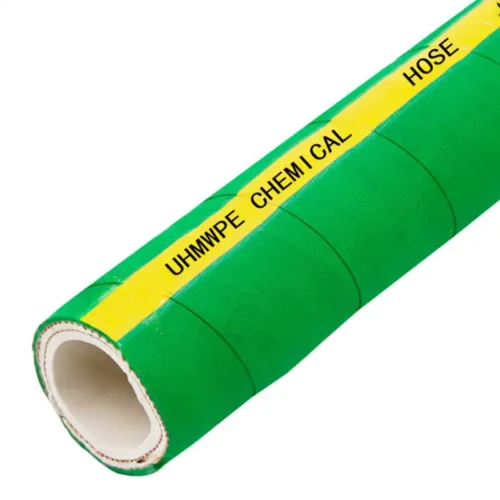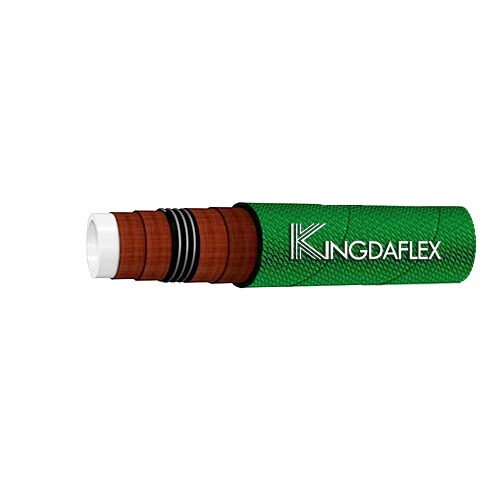Chemical hoses play a critical role in industrial applications, ensuring the safe and efficient transfer of various chemicals and fluids. These specialized hoses are designed to withstand the unique challenges posed by handling corrosive, abrasive, and hazardous materials.
In this article, we’ll delve into chemical hoses, exploring their composition, applications, benefits, and best practices for their use.
What Is Chemical Hose
A chemical hose is a specialized type of industrial hose designed for the safe and efficient transfer of various chemicals and fluids in industrial settings.
These chemical hoses are essential for industries that deal with corrosive, abrasive, and hazardous materials, as they ensure the protection of personnel, equipment, and the environment during the transfer process.
What Is Chemical Hose Made of

Chemical hoses are carefully crafted using a combination of specialized materials to ensure their ability to handle a wide range of corrosive and hazardous chemicals.
These materials are chosen for their remarkable resistance to chemical reactions, abrasion, and degradation caused by the substances they come into contact with. The construction of a chemical hose involves several layers that work together to provide both durability and safety during the transfer of chemicals.
Inner Tube:
The innermost layer of a chemical hose is the inner tube, which directly comes into contact with the chemical being transferred. This tube is typically made from synthetic rubber compounds or specially formulated thermoplastics. The choice of material depends on the specific type of chemical the hose will handle. These materials are selected to prevent chemical reactions, ensuring that the hose remains stable and intact during the transfer process.
Reinforcement Layer:
Surrounding the inner tube is the reinforcement layer. This layer is designed to provide strength and structural integrity to the hose. Common reinforcement materials include textile fibers, steel wire helix, or multiple layers of synthetic fabrics. The reinforcement layer prevents the hose from collapsing under vacuum or bursting under high pressure, enhancing its overall durability.
Cover:
The outermost layer of the chemical hose is the cover, which protects the inner layers from external factors such as abrasion, sunlight, ozone, and chemical exposure. This layer is also made from synthetic rubber compounds or thermoplastic materials, selected for their resistance to the environment in which the hose will be used. The cover may also have additional properties, such as being flame-resistant or anti-static, depending on the application.
A chemical hose is made of multiple layers that work in tandem to ensure the safe and efficient transfer of corrosive and hazardous chemicals. The inner tube prevents chemical reactions, the reinforcement layer provides strength, and the cover shields the hose from external factors. This careful construction allows chemical hoses to effectively handle a wide range of chemicals while maintaining the safety of personnel, equipment, and the environment.
Composition and Materials
Chemical hoses are meticulously crafted using materials that offer exceptional resistance to the chemicals they will come in contact with. Common materials include synthetic rubbers, thermoplastics, and fluoropolymers. These materials provide high levels of chemical resistance and prevent the hose from deteriorating when exposed to aggressive substances.
Types of Chemical Hoses

There are various types of chemical hoses, each tailored to specific applications and requirements. Some hoses are engineered for transferring aggressive acids, while others excel at handling abrasive materials. Selecting the right type of hose ensures optimal performance and safety.
Chemical hoses come in various types, each designed to meet specific requirements and handle different types of chemicals.
The choice of chemical hose depends on factors such as the type of chemicals being transferred, the operating conditions, and the industry in which they are used. Here are some common types of chemical hoses:
- Acid and Chemical Transfer Hoses: These hoses are specifically engineered to handle a wide range of acids, alkalis, and other corrosive chemicals. They are designed with materials that offer high chemical resistance to prevent chemical reactions and degradation.
- UHMWPE Chemical Hoses: Hoses made from Ultra-High Molecular Weight Polyethylene (UHMWPE) are known for their exceptional resistance to chemicals and abrasion. They are commonly used for the transfer of aggressive chemicals and solvents.
- Composite Hoses: Composite hoses are constructed from multiple layers of different materials, such as thermoplastics, metals, and fabrics. This layered construction provides excellent chemical resistance and flexibility, making them suitable for a variety of chemical applications.
- PTFE Hoses: Hoses made from Polytetrafluoroethylene (PTFE), commonly known as Teflon, offer superior chemical resistance and can handle extremely corrosive chemicals. They are often used in industries such as pharmaceuticals and food processing.
- Chlorine Transfer Hoses: These hoses are specifically designed for the safe transfer of chlorine gas. They are constructed with materials that can withstand the unique challenges posed by handling chlorine.
- Petroleum Hoses: While not designed exclusively for chemicals, petroleum hoses are capable of handling a wide range of chemicals in addition to petroleum products. They are commonly used in industries involving oil and fuel.
- Bulk Material Handling Hoses: These hoses are used for transferring abrasive materials, such as powders, granules, and slurries. They are built to withstand the wear and tear caused by abrasive substances.
- Vapor Recovery Hoses: Vapor recovery hoses are designed to safely handle volatile chemicals and gases. They prevent the escape of harmful vapors into the environment during the transfer process.
- Food-Grade Chemical Hoses: These hoses are designed for the transfer of food and beverage products, as well as non-fatty and non-oily substances. They comply with FDA and NSF standards to ensure food safety.
- Pharmaceutical Hoses: Similar to food-grade hoses, pharmaceutical hoses are designed for transferring chemicals used in pharmaceutical production. They adhere to strict quality and safety standards.
- Agricultural Chemical Hoses: These hoses are used in agricultural applications to transfer fertilizers, pesticides, and other chemicals used in crop management.
- Tank Truck Hoses: Tank truck hoses are used to transfer chemicals from storage tanks to delivery trucks. They are designed to handle the rigors of loading and unloading operations.
Each type of chemical hose has its own set of advantages and limitations. Selecting the right type of hose is crucial to ensure the safe and efficient transfer of chemicals while minimizing the risk of leaks, contamination, and accidents. It’s important to consider factors such as chemical compatibility, temperature, pressure, and the specific requirements of the application when choosing a chemical hose.
Applications of Chemical Hoses

Manufacturing Industry
Chemical hoses find extensive use in manufacturing plants for the safe movement of chemicals used in production processes. From transporting raw materials to conveying finished products, chemical hoses are essential for maintaining operational efficiency.
Chemical Processing Plants
In chemical processing plants, where a wide range of corrosive chemicals are handled, chemical hoses prevent leaks and ensure the protection of personnel and equipment. These hoses are integral to preventing accidents and maintaining the integrity of the products being manufactured.
Laboratory Settings
Laboratories also rely on chemical hoses to transfer fluids and chemicals between different apparatuses. Whether in educational institutions or research facilities, chemical hoses ensure accurate and controlled movement of substances.
Benefits of Using Chemical Hoses

Chemical Compatibility
Chemical hoses are designed to be compatible with specific chemicals, preventing chemical reactions that could compromise the hose’s integrity and the safety of operations.
Durability and Longevity
The robust construction of chemical hoses enhances their durability, even in challenging environments. This durability minimizes the risk of leaks, contributing to the safety of both personnel and the environment.
Safety and Environmental Protection
By preventing leaks and spillage, chemical hoses play a crucial role in safeguarding human health and the environment. They reduce the chances of chemical exposure and contamination.
Selecting the Right Chemical Hose
Compatibility Assessment
Before selecting a chemical hose, it’s essential to evaluate the compatibility between the hose material and the chemicals it will handle. This assessment ensures that the hose won’t degrade or react with the substances being transferred.
Temperature and Pressure Ratings
Different chemicals require specific temperature and pressure conditions for safe handling. Choosing a chemical hose with appropriate temperature and pressure ratings is essential to prevent accidents.
Flexibility and Bend Radius
The flexibility and bend radius of a chemical hose determine its ease of use in various applications. Hoses that are too stiff may be challenging to maneuver, while excessively flexible hoses might not withstand the demands of the application.
Proper Handling and Maintenance
Inspection and Testing
Regular inspection and testing of chemical hoses are essential to identify signs of wear, damage, or deterioration. Addressing potential issues early on can prevent accidents and extend the lifespan of the hose.
Storage Guidelines
Proper storage of chemical hoses involves keeping them away from direct sunlight, extreme temperatures, and chemicals that may degrade the hose material.
Cleaning and Maintenance
Cleaning chemical hoses after each use helps prevent chemical residues from accumulating and potentially causing contamination or reactions in subsequent transfers.
Industry Regulations and Standards
REACH and ROHS Compliance
Chemical hoses must adhere to regulations such as REACH (Registration, Evaluation, Authorization, and Restriction of Chemicals) and ROHS (Restriction of Hazardous Substances) to ensure the safety of personnel and the environment.
FDA and NSF Approvals
For chemical hoses used in food and beverage applications, compliance with FDA (Food and Drug Administration) and NSF (National Sanitation Foundation) standards is crucial to prevent contamination and ensure consumer safety.
Conclusion
Chemical hoses are essential for safe and efficient handling of hazardous substances across various industries. Understanding the different types, materials, and considerations outlined in this guide empowers you to make informed decisions and select the most suitable chemical hose for your specific needs.
Ready to find the perfect chemical hose for your application? Contact us today to explore our extensive range of high-quality, wholesale chemical hoses. Our expert team can assist you in selecting the ideal solution for your specific requirements.
Frequently Asked Questions (FAQs)
What materials are chemical hoses typically made from?
Chemical hoses are commonly made from synthetic rubbers, thermoplastics, and fluoropolymers due to their exceptional chemical resistance.
Can chemical hoses be used for food-grade applications?
Yes, some chemical hoses are designed for food and beverage applications, and they adhere to FDA and NSF standards.
How often should chemical hoses be inspected?
Regular inspection, before and after each use, is recommended to identify wear, damage, or signs of degradation.
Are there guidelines for transporting hazardous chemicals?
Yes, there are regulations and guidelines, such as REACH and ROHS, that chemical hoses must adhere to when handling hazardous substances.
What is the typical lifespan of a chemical hose?
The lifespan of a chemical hose depends on various factors, including the materials used, the chemicals being transferred, and the operating conditions. Regular inspection and proper maintenance can extend the hose’s lifespan.



